
Invisible Inc. Review
My relationship with games by Klei Entertainment has been quite rocky, to say the least. I still remember the excitement that filled me up when I started playing Mark of the Ninja. Oh, the lights! The shadows! The sneaky stabs and the suspicious guards! For an enthusiast of stealth games like me, seeing the whole genre refreshed in 2D was thrilling, but as well executed as it may have been, there was something there that never clicked with me. A year passed and I got my hands on Don’t Starve, a completely different game in all aspects, where only in the comic-y bits you could see a glimpse of Klei’s legacy. Oh, the tree-chopping! The dogging pumpkin-chest! Yeah, you get the idea: I’ve got memories of this game, settled cosily somewhere in my cold heart. However, with Don’t Starve, I had the same moment of disenchantment that I had with Mark of the Ninja. These two games started feeling repetitive and formulaic. The first one struggled keeping me entertained in its story until the very end, and the second one sinned by being too roguelike — not a fan.
Klei’s latest game, Invisible Inc., is like a museum of indie videogames. As you play, you will identify countless design tropes from many well-known indie titles — all the ones I spotted are pointed out below. Invisible Inc. is a turn-based stealth game, and another roguelike, you know, with ‘procedurally generated levels’, ‘permadeath’ and all that mumbo-jumbo. For me, roguelike always translates into doing the same thing over and over until, pretty much due to luck in how the variables play out, I am able to finish the poorly designed plot. I enjoy with bells on the first few goes, but then it becomes increasingly tedious. Now, in many of these videogames, the goal is simply to make it as far as possible, but very few offer you an array of approaches varied enough to keep you trying over and over. Usually, the only motivation is the self-imposed challenge of outdoing your last score, which for me is not enough. As much as I appreciate metagame context, it is the actual game and its assets which must keep me coming back to it. Invisible Inc. has an actual narrative, sometimes clumsy and disengaging, so similarly to Don’t Starve, I didn’t keep trying over and over solely for the mechanics.
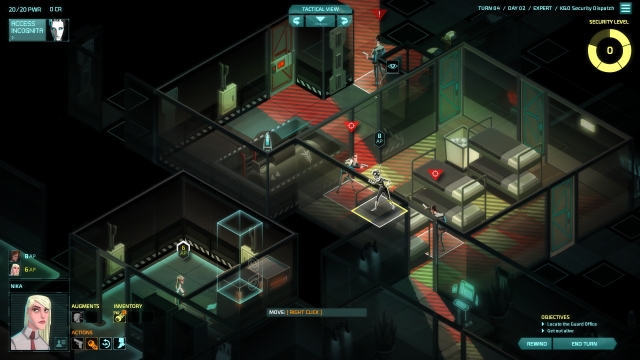 So what’s the story about? Well, it starts with a cartoony cutscene, with loads of people you have zero knowledge about, being raided by security forces. You control two agents, which you pick before you start your campaign. Alongside Central, the head of the agency, you are the only ones remaining from Invisible, an uncovered undercover organisation with a blurry purpose, operating within international corporative arena. The game is set in an ultra-computerised 2074, with frivolous references to wars and other events, giving a bit of background to what’s happened in between now and then. It is very reminiscing of games such as Republique, inspired in an over-controlled, over-digitalised and over-secured society. The agency’s best asset is Incognita, an AI able to hack and access every machine connected to the network and keep you under the radar. Making use of it, you must re-establish HQs and find a new neuralgic centre for the AI before it runs out of battery and the agency’s caught with its pants down. And the way to do this is by infiltrating in a bunch of corporate facilities worldwide.
So what’s the story about? Well, it starts with a cartoony cutscene, with loads of people you have zero knowledge about, being raided by security forces. You control two agents, which you pick before you start your campaign. Alongside Central, the head of the agency, you are the only ones remaining from Invisible, an uncovered undercover organisation with a blurry purpose, operating within international corporative arena. The game is set in an ultra-computerised 2074, with frivolous references to wars and other events, giving a bit of background to what’s happened in between now and then. It is very reminiscing of games such as Republique, inspired in an over-controlled, over-digitalised and over-secured society. The agency’s best asset is Incognita, an AI able to hack and access every machine connected to the network and keep you under the radar. Making use of it, you must re-establish HQs and find a new neuralgic centre for the AI before it runs out of battery and the agency’s caught with its pants down. And the way to do this is by infiltrating in a bunch of corporate facilities worldwide.
The more missions you do, the better you can pinpoint where the global Security Network (SecNet) is, where you’re supposed to re-activate Incognita. And here comes the count-down; with 72 hours, you must gather resources and information in every facility, until you’ve done enough missions to discover its location. The missions’ difficulty increases with every incursion you do, but the newly acquired abilities and gadgets should help smooth those spikes. The rewards of each mission vary, which forces you to select them carefully— from augmentations for the agents, just like in Deus Ex but with a more strategic aspect, to information about other facilities or simply credits to spend on upgrades. The more you play, the more experience you gain, and with it, the more agents you unlock to choose from in later tries. Because there will be later tries.
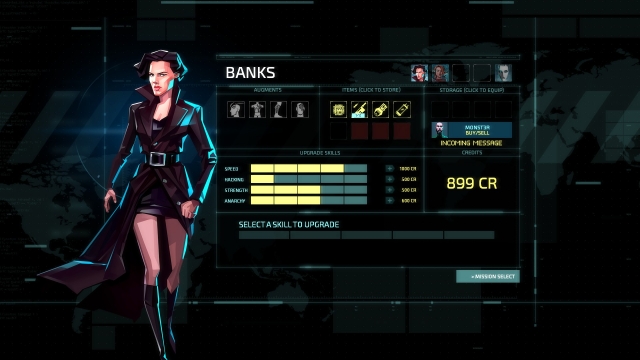 Invisible Inc. is incredibly unforgiving if you dare to set the difficulty higher than beginner, to the point that you won’t be able to undo any move that you make, just like in Shadowrun or FTL. If you fail a mission because the agents die, that’s it for you, the agents and the agency itself. Farewell to those four hours you’ve spent sneaking through missions, because you will have no choice other than start from the beginning. This feature is very common and understandable in roguelike games, which makes them open to different approaches in every try, but it feels much more painful here that there’s a plot to follow that just — *poof* — vanishes, and that I’ve invested so much in my agency and characters. This is incredibly motivating and forces you to thoroughly think every action through, making every single moment you’re playing count.
Invisible Inc. is incredibly unforgiving if you dare to set the difficulty higher than beginner, to the point that you won’t be able to undo any move that you make, just like in Shadowrun or FTL. If you fail a mission because the agents die, that’s it for you, the agents and the agency itself. Farewell to those four hours you’ve spent sneaking through missions, because you will have no choice other than start from the beginning. This feature is very common and understandable in roguelike games, which makes them open to different approaches in every try, but it feels much more painful here that there’s a plot to follow that just — *poof* — vanishes, and that I’ve invested so much in my agency and characters. This is incredibly motivating and forces you to thoroughly think every action through, making every single moment you’re playing count.
The main remarkable trope is the turn-based system, gathered from games like XCOM or the aforementioned Shadowrun. However, this is not a combat system. The approach that you must take in each mission must be of combat-avoidance, sneaking through the level raising the alarm as little as possible, and you must do this fast. For every turn you take, or if you mess up and get detected, the alarm level increases a little, fortifying the security measures — making hacks more difficult, activating more cameras or bringing more guards in. The rub is in the fact that the levels are not linear: there are many safes and devices that you can take advantage of scattered throughout, and many rooms you can go in. Hence, you don’t know where your primary target or the extraction point is, or where the juiciest safes may be. They can be all lumped together or in each corner of the level, but you don’t know that. Yes, you can take out guards, usually for a few turns, but that makes them more suspicious; you are better off focusing on gathering resources and exploring the level as much as you can.
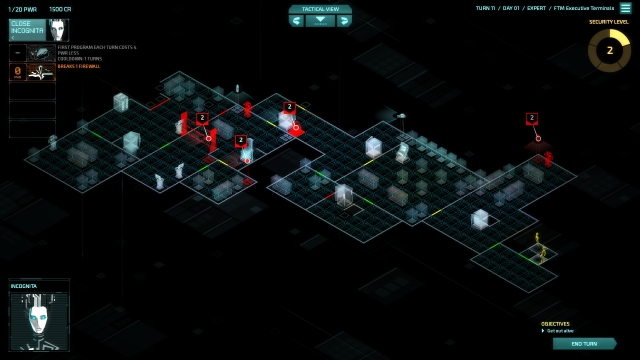 The key of this game is information and discern, a great way to shift the focus away from the action itself. This makes the game feel fresh and innovative, even though the basic mechanics are taken from a variety of games. The mentality that you have to approach this game with is unique and completely different from any other game. Every level is procedurally generated, and you start with knowledge of only what your eye can reach, as I’ve explained. You need to know as soon as possible how the level is and what room hides what, so you can manage the turns, the agents and power you use completing each task. Is it worth it to knock out that guard for those extra credits he holds, or avoid him and search for an upgrading machine? Do I want to risk taking a few more turns and spawning more guards just to get the credits in that safe? The same goes with the abilities and gadgets; you must tailor your agents to be complementary but efficient individually, levelling up speed, hacking, etc. In this way, it reminds me of FTL, where visiting a new quadrant is a risk, but the rewards are very necessary; but in every try, the combination of gadgets, agents and abilities will be different.
The key of this game is information and discern, a great way to shift the focus away from the action itself. This makes the game feel fresh and innovative, even though the basic mechanics are taken from a variety of games. The mentality that you have to approach this game with is unique and completely different from any other game. Every level is procedurally generated, and you start with knowledge of only what your eye can reach, as I’ve explained. You need to know as soon as possible how the level is and what room hides what, so you can manage the turns, the agents and power you use completing each task. Is it worth it to knock out that guard for those extra credits he holds, or avoid him and search for an upgrading machine? Do I want to risk taking a few more turns and spawning more guards just to get the credits in that safe? The same goes with the abilities and gadgets; you must tailor your agents to be complementary but efficient individually, levelling up speed, hacking, etc. In this way, it reminds me of FTL, where visiting a new quadrant is a risk, but the rewards are very necessary; but in every try, the combination of gadgets, agents and abilities will be different.
In Invisible Inc., much like in Republique, you can hack into devices using Incognita. Apart from credits, the currency of the game, there is another resource management feature, power. In order to hack into every safe, device, or guard’s armour, you’ll need to consume a certain amount of power. In the same way you upgrade agents and give them abilities, you should do the same with Incognita, as it’s essential to be swift, effective and adaptive. By being part of the chore mechanics, it gives variety to how you play, making you pay attention to more things other than the agents. Incognita becomes important to the plot further in as a character, rather than a tool, but unfortunately I don’t see it as more than a gimmick, just like the wide variety of difficulty levels. The game doesn’t really change that much whether you narrow down the time frame or make it even more difficult, so it feels like a shallow method to keep you playing. It’s a pity to see that they relied on such a cheap tactic when they could have developed the plot further. After all, even though the end level is indeed very climactic, the ending of the story itself is disappointing, leaving too big of a hole, and turning out slightly absurd.
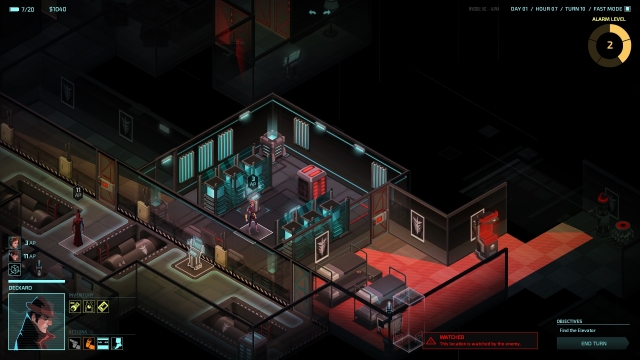 Invisible Inc. has been compared to games like Frozen Synapse, but it rather seems to be a combination of the two previous Klei’s games, but with its clear FTL and XCOM influences thrown around. It’s based around stealth, just like Mark of the Ninja, but with a very roguelike approach, like Don’t Starve. Now, do I see myself playing now that I’ve completed the campaign? Yes, but not for long. Don’t get me wrong, this game is absolutely fantastic, and its mechanics are incredibly engaging, but I feel that, like any other roguelike, they’re not enough by themselves. Indeed, this game’s the pinnacle of roguelikes, or at least as far as my knowledge goes, but I can’t shake the feeling that a more structured, linear and orthodox campaign would have helped me sink in with the characters and encouraged me to play this game for longer. I loved this game, and I want more of it. Sadly, my options for more won’t keep me satisfied, as it will be the same thing, over and over. Oh, roguelikes, you’re always so close to perfection.
Invisible Inc. has been compared to games like Frozen Synapse, but it rather seems to be a combination of the two previous Klei’s games, but with its clear FTL and XCOM influences thrown around. It’s based around stealth, just like Mark of the Ninja, but with a very roguelike approach, like Don’t Starve. Now, do I see myself playing now that I’ve completed the campaign? Yes, but not for long. Don’t get me wrong, this game is absolutely fantastic, and its mechanics are incredibly engaging, but I feel that, like any other roguelike, they’re not enough by themselves. Indeed, this game’s the pinnacle of roguelikes, or at least as far as my knowledge goes, but I can’t shake the feeling that a more structured, linear and orthodox campaign would have helped me sink in with the characters and encouraged me to play this game for longer. I loved this game, and I want more of it. Sadly, my options for more won’t keep me satisfied, as it will be the same thing, over and over. Oh, roguelikes, you’re always so close to perfection.
Invisible, Inc. (Reviewed on Windows)
Excellent. Look out for this one.
This game's turn-based stealth mechanics are perfect in every way, unforgiving and challenging. However, it's sad to see a game almost nailing it due to the roguelike campaign, which feels lazy and incomplete.



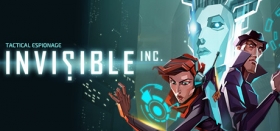







COMMENTS